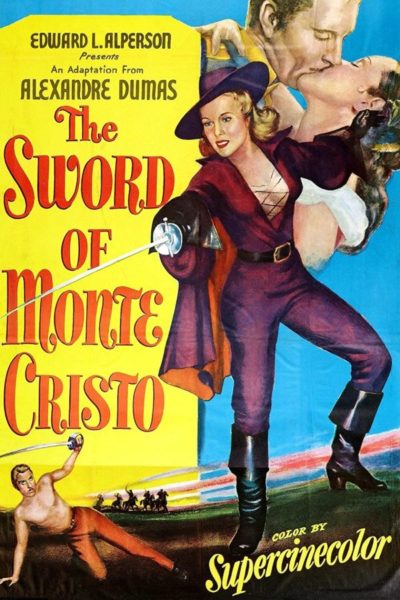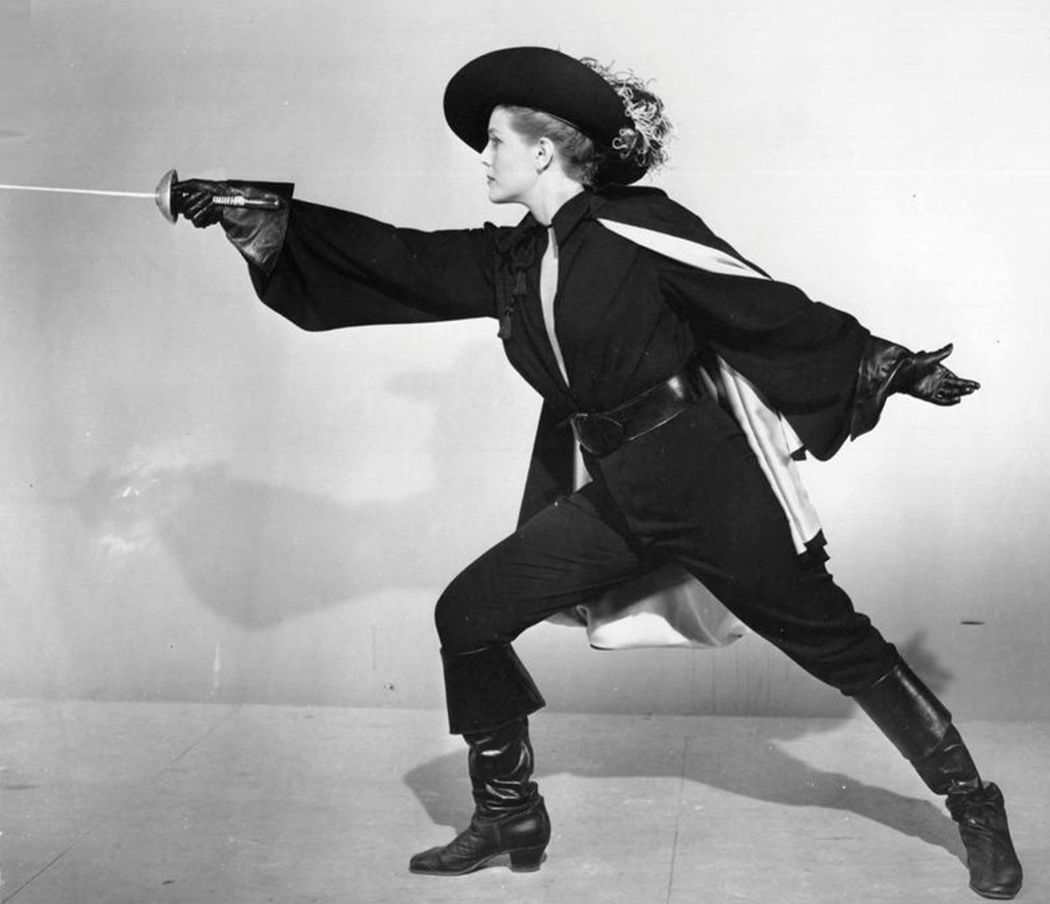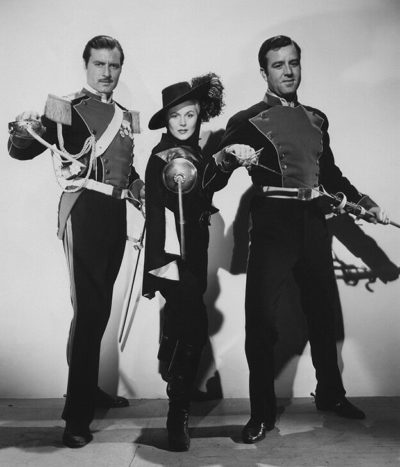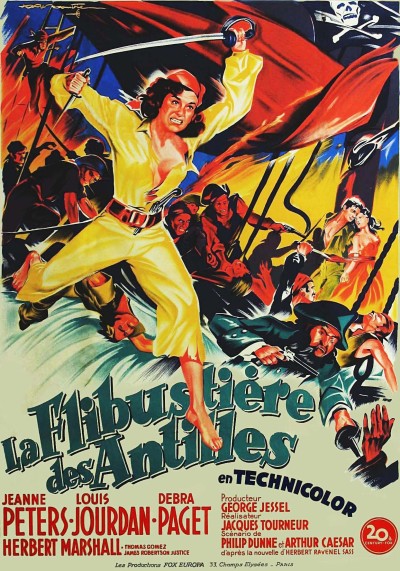★★★
“Raiders of the Lost Monte Cristo Ark”
 This 1951 movie is a bit clichéd. But then one has to consider that a lot of these weren’t clichés at the time the movie was made. That said, you will find everything here that you might expect from such a movie: A good king, his evil scheming brother who wants his throne, a dashing captain who has his way with the ladies, revolting citizens, a hidden treasure and a beautiful lady.
This 1951 movie is a bit clichéd. But then one has to consider that a lot of these weren’t clichés at the time the movie was made. That said, you will find everything here that you might expect from such a movie: A good king, his evil scheming brother who wants his throne, a dashing captain who has his way with the ladies, revolting citizens, a hidden treasure and a beautiful lady.
Though, and this is where the film diverts from the usual formula, said lady is actually the hero. Countess Christianne (Corday) is supporting the oppressed farmers and citizens against the dictatorship of King Louis Napoléon (the II. or the III.? I don’t know.) in 1858. But truth is Louis (David Bond) is not the real villain here, he was placed in the position of the king due to his brother, Charles LaRoche (Kroeger), because only someone named Napoleon was entitled to become king. LaRoche is the one who’s actual actions terrorize the people.
In secret, LaRoche is planning to overthrow Louis’ government and replace his ministers with people who serve and obey him. Lady Christianne wants to use the famous treasure of the Count of Monte Cristo (who was a friend of her late father) to finance the revolution, since the citizens and farmers have no means to buy weapons. When LaRoche finds out about that treasure, he imprisons Christianne’s uncle and tries to find out the secret code (embedded in Monte Cristo’s famous sword) that will lead him to the treasure.
Well, this is definitely not an adaptation of the Count of Monte Cristo novel by Alexandre Dumas as the title claims. As a matter of fact, it just uses the famous name, probably hoping to dupe audiences into believing they would see something based on the literary source. Casual name dropping is so much fun (e. g. Lady Christianne has a very big dog that she calls “Richelieu”!). It’s of course a typical product of its time, somewhere between the pirate movies, that were already on their way out of Hollywood, and before the glut of biblical epics that would soon invade the silver screens.
In Germany we call that genre “coat and sword“, I think in English it’s being called “cloak and dagger“? [Jim: I think those are more like spy movies: these would be… swashbucklers?] At that time these kind of historical adventure movies were very much en vogue. In 1948 The Three Musketeers with Gene Kelly had come out, and in 1952 Stewart Granger cemented his star status with Scaramouche. What makes this film stand out (and qualifies it for inclusion on this site) is the already mentioned fact that “Countess Christianne“ is the main hero here. In dark garb, she rides through the night, persuading the citizens who have almost given up on their revolt to continue the good fight, and appears with her large black hat and mask like a female version of Zorro.
Yes, the movie can’t entirely escape the attitudes of its time: There is the dashing charming Captain Renault (Montgomery) who, in a running gag, can’t for the life of him remember the name of the bar maid, with whom he obviously once had an affair. He seemed to have had quite a number of them. And of course, he’s attracted to Lady Christianne.
 When he enters her private rooms, after she has just redressed as her normal self again, he takes – unasked – a seat and puts his shoes on the table. He also forces a kiss on Lady Christianne. When she snaps, “You don’t behave like a gentlemen should!“ he answers, “Well, you don’t behave like a woman should!“ You are left a bit baffled wondering how women in 1951 were supposed to behave when being kissed involuntarily, by an unknown stranger, who just entered your home through the window? But then even her nanny seems to agree (“A young lady shouldn’t run away from a man, she should catch one!”). How things have changed since that time!
When he enters her private rooms, after she has just redressed as her normal self again, he takes – unasked – a seat and puts his shoes on the table. He also forces a kiss on Lady Christianne. When she snaps, “You don’t behave like a gentlemen should!“ he answers, “Well, you don’t behave like a woman should!“ You are left a bit baffled wondering how women in 1951 were supposed to behave when being kissed involuntarily, by an unknown stranger, who just entered your home through the window? But then even her nanny seems to agree (“A young lady shouldn’t run away from a man, she should catch one!”). How things have changed since that time!
Though, the Captain (to whom Lady Christianne is of course attracted to) is not really on the side of evil LaRoche. He is just bound by duty and will, in the end fight, and kill LaRoche as you expect from a man in love with the beautiful lady. So there is hope for this guy! The movie’s budget and time must have been very limited. Essentially, the feeling is you have just 4-6 locations, with one being the local pub, another the home of Christianne and her uncle, and one some grass fields with a bit of woods between those. But the movie never gets boring. Though it’s from 1951 it has enough movement, dynamic and intrigue to keep your interest through its short 76-minute run time.
 Countess Christianne does enough riding, fencing and chandelier-swinging to be rightfully included in the genre of female action heroines. Yes, she is not alone: Captain Renault comes across like a second-class Errol Flynn, supporting her and hinting as to her “true motives“ for cross-dressing and fighting (“You don’t fight against the king! I think, you are fighting against your female nature!“). Though Renault kills the big bad, she still has a mind of her own, riding with the Royal dragoons and killing off LaRoche’s right-hand man, Major Nicolet (Conrad).
Countess Christianne does enough riding, fencing and chandelier-swinging to be rightfully included in the genre of female action heroines. Yes, she is not alone: Captain Renault comes across like a second-class Errol Flynn, supporting her and hinting as to her “true motives“ for cross-dressing and fighting (“You don’t fight against the king! I think, you are fighting against your female nature!“). Though Renault kills the big bad, she still has a mind of her own, riding with the Royal dragoons and killing off LaRoche’s right-hand man, Major Nicolet (Conrad).
I don’t know any of the actors in this historical adventure movie: Rita Corday was only in movies for a short time, from 1943–1954. On the other hand, Montgomery (of whom I’ve also never heard) had a very long movie career from the early 30’s to somewhere in the 80s. The only actor I recognize is William Conrad (playing the supporting role of Major Nicolet) who would later become a well-known TV-star thanks to his many series (Cannon, Nero Wolfe, Jake & McCabe). Here he is quite young but appears in good form when fencing.
Overall, Sword of Monte Cristo is a nice little classic movie that doesn’t hurt, yet isn’t a “must-see“. But considering the era it was produced in, it’s noteworthy: how many genre films do you know from this time where a female would be the main character? Though, it’s still no match for Anne of the Indies, which came out the same year.
Dir: Maurice Geraghty
Star: Rita Corday, George Montgomery, Berry Kroeger, William Conrad





















